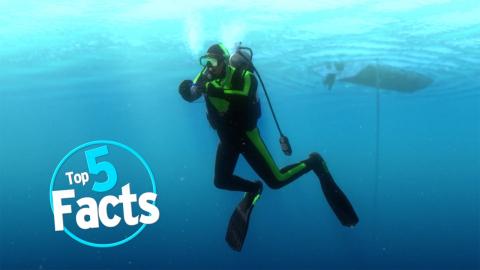Top 5 Scuba Diving Facts

In the deep blue sea, a basic understanding of aquatic realities can mean everything. Welcome to WatchMojo's Top 5 Facts. In this instalment, we're counting down the 5 most interesting facts that we could learn about scuba diving. Some of you may already know that scuba means self contained underwater breathing apparatus, and a few of you might even be part of the dive world's equivalent of the mile high club, the 20 metre club. But for those unfamiliar with the ways of the scuba, well, it's about to go down.
Special thanks to our users Christo or submitting the idea using our interactive suggestion tool at http://www.WatchMojo.comsuggest
#5: Wetsuits Keep Divers Warm Thanks to Nitrogen Gas Bubbles
After working on the Manhattan Project, an American physicist named Hugh Bradner invented the wetsuit in 1952, nine years after Jacques Cousteau and Emile Gagnan introduced the Aqua-lung. And while experienced divers fully understand the specifics of the neoprene design, not everyone realizes how a wetsuit works. Some think it’s the enclosed water actually warms the body, and sure, that helps. But it’s the bubbles of Nitrogen gas within the neoprene suit that keep the body warm. Nitrogen is a very poor conductor of heat, preventing the cold sea water from drawing out all your body heat. As long as the suit fits tight, the enclosed water won’t flush out, thus allowing the gas to keep the body heated.
#4: Altitude Diving Happens at 1,000 Feet Above Sea Level
Ok, so any dive below sea level may be enough for some of you, but others need something more. And for some, that something is “Altitude Diving,” which takes place at 300 meters or 1,000 feet above sea level. Before executing the dive, you’ll need the proper knowledge and the proper legal documents too. And that’s because of the potential decompression sickness from the reduced atmospheric pressure. In fact, the U.S. Navy recommends a 12 hour wait before making the dive, and a system known as “Cross Corrections” helps divers make the necessary calculations. So, what’s the most ambitious altitude dive? Well, that took place at Chile’s Lago Licancabur in 1982, measured at approximately 19,000 feet above sea level.
#3: Decompression Sickness Is Not Just for Scuba Divers
Divers learn very early on that they must control the rate of their ascension or face very serious consequences: decompression sickness, a horrible, debilitating illness caused by the formation of nitrogen in your tissues and bloodstream. Commonly referred to as “DCS” or simply “the bends,” the condition is also known as “caisson disease.” And the term inadvertently arose through American industrialism. In the 19th century, when feats of engineering had to be performed underwater, workers toiled away in the compressed atmospheres of caissons. Unfortunately, before 1841, nobody knew decompression sickness was a thing. And in 1873, the construction of the Brooklyn Bridge led to a sobering reminder of what people endured in the name of engineering, with a 110 recorded cases of decompression sickness.
#4: Altitude Diving Happens at 1,000 Feet Above Sea Level
Ok, so any dive below sea level may be enough for some of you, but others need something more. And for some, that something is “Altitude Diving,” which takes place at 300 meters or 1,000 feet above sea level. Before executing the dive, you’ll need the proper knowledge and the proper legal documents too. And that’s because of the potential decompression sickness from the reduced atmospheric pressure. This is a danger at sea level as well, but high altitudes make it even more complicated. In fact, the U.S. Navy recommends a 12 hour wait before making the dive, and a system known as “Cross Corrections” helps divers make the necessary calculations. So, what’s the most ambitious altitude dive? Well, that took place at Chile’s Lago Licancabur in 1982, measured at approximately 19,000 feet above sea level.
#1: Colors Disappear Underwater
Reality takes on a different form underwater. Because water absorbs different wavelengths of light to different degrees, as you go deeper underwater, colors effectively disappear from the visible spectrum one by one. At roughly 15 feet, cutting yourself would mean bleeding blue blood. At about 25 feet, your tangerine will look more like an oversized blueberry. At around 150 feet, you’ll have no idea which M&Ms to eat first and which to eat last, because they’ll all look the same. You’ll scream in frustration, which will confuse the rest of your diving party because sound travels nearly four and a half times faster underwater, making it difficult to determine the source of sound. The world under the sea is much different than life above.
So what fact about scuba diving surprises you the most? And where my 20 metre club members at? For more crunk top 10s and leaky wetsuit Top 5s, be sure to subscribe to WatchMojo.com
